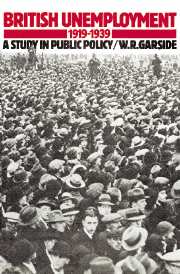Book contents
- Frontmatter
- Contents
- List of tables
- Preface
- Acknowledgements
- PART I INTRODUCTION
- PART II THE LABOUR MARKET UNDER STRAIN
- 2 Defensive action: unemployment relief and public assistance, 1919–1932
- 3 Means to an end: insurance, assistance and the categorization of the unemployed, 1932–1939
- 4 In and out of the labour market: hours of work, pensions and the school-leaving age
- PART III THE INTERNATIONAL CONTEXT
- PART IV STRUCTURAL UNEMPLOYMENT, INDUSTRY AND THE REGIONS
- PART V MACROECONOMIC POLICY OPTIONS: THEORY AND PRACTICE
- Bibliography
- Index
4 - In and out of the labour market: hours of work, pensions and the school-leaving age
Published online by Cambridge University Press: 21 September 2009
- Frontmatter
- Contents
- List of tables
- Preface
- Acknowledgements
- PART I INTRODUCTION
- PART II THE LABOUR MARKET UNDER STRAIN
- 2 Defensive action: unemployment relief and public assistance, 1919–1932
- 3 Means to an end: insurance, assistance and the categorization of the unemployed, 1932–1939
- 4 In and out of the labour market: hours of work, pensions and the school-leaving age
- PART III THE INTERNATIONAL CONTEXT
- PART IV STRUCTURAL UNEMPLOYMENT, INDUSTRY AND THE REGIONS
- PART V MACROECONOMIC POLICY OPTIONS: THEORY AND PRACTICE
- Bibliography
- Index
Summary
Although public disquiet and party politics convinced Ministers that they had to be seen to be ‘doing something’ on behalf of the involuntarily unemployed, the adoption of alternative strategies beyond insurance and relief was constrained for much of the 1920s by the lingering belief that in the restoration of pre-war normality lay the basis of future prosperity and stability. It was thus the acknowledged responsibility of officials to shape policy according to their assessment of prevailing conditions without undermining the ‘natural’ impulses to economic recovery.
Remedial policy did not always work in that direction; witness the challenge which the revamped insurance scheme posed to orthodox finance. But with the search for politically acceptable responses to unemployment to the fore, pressure groups within and outside of Whitehall were tempted to popularize policies seemingly blessed with the virtue of commonsense. With insufficient work for all it seemed obvious to consider sharing available jobs amongst the labour force by changes in working hours. Intense competition for vacancies, moreover, suggested the possibility of manipulating the supply of labour at each end of the age scale, either by extending the period of compulsory schooling or by revising the terms governing the availability of retirement pensions. It is with these related issues that this chapter is concerned.
- Type
- Chapter
- Information
- British Unemployment 1919–1939A Study in Public Policy, pp. 88 - 112Publisher: Cambridge University PressPrint publication year: 1990



